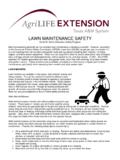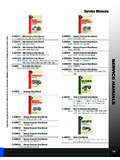Transcription of Native Ground Covers of Western Pennsylvania for Lawn ...
1 Why replace your lawn ? There are many benefits of replacing traditional turf lawns and landscaping with Native plants, which is also know as naturescaping. lawn maintenance is time consuming, ener- gy intensive, expensive and can be toxic. Choosing the right plants can drastically reduce or eliminate the maintenance required on your property. Native Ground Covers of According to the EPA, one traditional gas powered lawn mower emits 88lbs of the greenhouse gas CO2 per year. Western Pennsylvania The same mower also emits high levels of carbon monoxide, volatile organic compounds and nitrogen oxides, producing for lawn Alternatives up to 5% of the nation's air pollution. One lawn mower run for one hour emits the equivalent air pollution of eleven cars being driven at 55mph for one hour.
2 Created by the Moon Township Green Initiatives Department Lawns need to be mowed roughly once per week during the Questions? Contact growing season to keep up with municipal standards. How much time do you spend in the spring and summer mowing your lawn to avoid a high grass notice? How often do you hear the loud hum of the lawn mower in your neighborhood? Do you spray your lawn with chemicals to keep it lush and Works Cited green? Naturescaping means a reduction in carbon emis- Plant Finder. Missouri Botanical Garden, Web. 19 Mar. sions, air and noise pollution and potentially toxic chemicals;. 2015. it's a time, money and energy saver. Cleaner Air : Gas Mower Pollution Facts. Cleaner Air: Mowing Emissions and Clean Air Alternatives.
3 A Fact Sheet. , Web. 29 Apr. 2015. The possibilities of replacements for a lawn are endless. PlantNative - Native Plants, lawn Alternatives, Landscape You could return the lawn to a meadow, grow food, or plant Design and Landscaping. PlantNative - Native Plants, lawn Al- Native wildflowers or trees to name a few. This pamphlet ternatives, Landscape Design and Landscaping. , Web. 29 Apr. 2015. explores Native to Western Pennsylvania , low-growing and low-maintenance groundcovers which act as a lawn alterna- tive for the front of your property, where municipal require- Special thanks to The Township of Moon & ments may prohibit returning to meadow or growing food. The Audubon Society of Western Pennsylvania For other ideas, a simple internet search will provide more than enough resources.
4 How to remove your grass Pennsylvania Sedge Carex pensylvanica Once you decide what to plant in place of your lawn , the Type: Rush or Sedge Easily grown in aver- grass needs to be suppressed. There are multiple methods Family: Cyperaceae age, dry to medium, Native Range: Canada, US well-drained soils in part for this: Zone: 3 to 8 shade to full shade. Pre- Height: to feet fers loose loams in dry Spread: to feet soils in sun-dappled part Bloom Time: May shade. Plants spread by Sheet Mulch it Sun: Part shade to full shade rhizomes and may self- This is also known as lasagna com- Water: Dry to medium seed in optimum growing Maintenance: Low conditions. posting. Using recycled brown card- Suggested Use: Ground cover , Naturalize, Rain Garden board or newspaper, spread multiple Tolerate: Heavy Shade, Wet Soil layers down over the grass you wish to eliminate and water thoroughly.
5 Pennsylvania Sedge typically grows in loose colonies with a creeping habit and is often Mulch with 3 of compost, wood chips found in areas with oak trees. It is semi-evergreen in moderately cold winter climates. or manure and let sit for about two months until the card- Typical garden uses include groundcover for dry shade, underplanting for shade pe- rennials, lawn substitute for dry soils in shady areas (forms a turf that never needs board has broken down and the soil is ready to be planted. mowing or mow 2-3 times per year to 2 tall). It may be best to use purchased plants for covering large areas because this species often does not grow well from seed. Shade it Out Plant things that will shade out the grass.
6 This can be done by planting viney, creep- Partridge Berry ing vegetables such as zucchini, pumpkins Type: Evergreen perennial Mitchella repens or other squash. This technique is not as Family: Rubiaceae Native Range: Eastern Canada, US. clean and precise as other methods, as Zone: 4 to 8. the shade out will happen where the plants Height: Up to two inches and trees decide to grow. Spread: 6-12 inch spines Bloom Time: Late Spring- Early Summer Sun: Part shade to full shade Water: Low to moderate watering- moist, but well-drained soil Hack it Up Maintenance: Low You could always take a pulaski to it and just Suggested Use: Ground cover , shade garden, berries used as medicinal herb Tolerate: Very cold winters, some drought hack it up.
7 This is time and energy intensive. You may also expose other weeds, which will Partridge Berry is a bautiful addition to winter gardens. During the cold days of late winter Partridge Berry shows off its deep, dark-green leaves and occasional scarlet need to be supressed by mulching the ex- berries. In a garden setting this evergreen prefers shade, accepting the morning sun. posed area or planting a cover crop. The best way to introduce this Native into your garden is through 1 year old cuttings or by division. In the garden situation they will form a thick, substantial Ground cover . Once established they are relatively trouble free with the only required maintenance of keeping garden debris from covering the mats.
8 Nodding Onion Spiderwort Allium cernuum Tradescantia virginiana Type: Bulb Type: Herbaceous perennial Family: Amaryllidaceae Blooms in summer. All Family: Commelinaceae Native Range: Canada to Mexico parts of this plant have Native Range: Eastern United States Zone: 4 to 8 an oniony smell when cut Zone: 4 to 9. Height: to feet or bruised. Although the Height: to feet Spread: to feet bulbs and leaves of this Spread: to feet Bloom Time: June - August plant were once used in Bloom Time: May to July cooking (stews) or eaten Bloom Description: Blue to violet-blue Bloom Description: Pink Sun: Part shade to full shade Sun: Full sun to part shade raw, nodding onion is Water: Medium Water: Dry to medium not generally considered Maintenance: Medium Maintenance: Low to be of culinary value Suggested Use: Naturalize Flower: Showy today.
9 Flower: Showy Leaf: Fragrant Tolerate: Clay Soil, Black Walnut Attracts: Butterflies Tolerate: Deer, Drought, Dry Soil, Shallow-Rocky Soil, Black Walnut Grow in average, medium moisture, well-drained soil in part shade to full shade. Prefers moist, acidic soils. Tolerant of poor soils. Divide clumps when Nodding Onion is easily grown in average, dry to medium, well-drained soil in they become overcrowded. Foliage declines after flowering and should then full sun to light shade. Plants will naturalize by self-seeding and bulb offsets in be cut back almost to the Ground to encourage new growth and a possible fall optimum growing conditions. Deadhead flowers before seed sets to help con- bloom.
10 Can self-seed and spread in ideal growing conditions. An interesting trol unwanted spread. Foliage persists past flowering into late summer and long-blooming perennial for Native plant gardens, woodland or shade gar- before dying back. Plants are easily grown from seed which should be planted dens, wild gardens or naturalized areas. in spring or from bulbs which should be planted in autumn. Field Pussytoes Blue Mistflower Antennaria neglecta Conoclinium coelestinum Type: Perennial forb/herb Type: Herbaceous perennial Family: Asteracae Family: Asteraceae Height: 4 inches- 12 inches Native Range: Central and Southeastern US, West Indies Bloom Time: April- June Height: to feet Bloom Description: White Bloom Time: July to October Habitat: Mesic to dry black soil prairies, clay prairies, Bloom Description: Blue slopes of open woodlands, dry meadows in wood Sun: Full sun to part shade land areas, savannas, shale glades, eroded clay Water: Medium, well drained banks, pastures, abandoned fields, and roadsides Maintenance: Medium Suggested Use.





